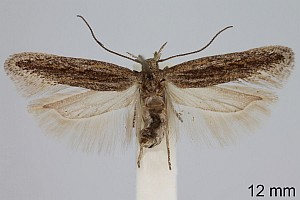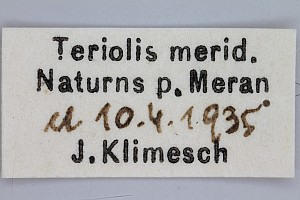

 +6Kontinente:EUAS
+6Kontinente:EUAS3. Biologie
3.1. Nahrung der Raupe
- [Asteraceae:] Artemisia campestris ? (Feld-Beifuß ?)
Bei Huemer & Karsholt (2010: 150) heißt es: "The larva has been recorded from Artemisia campestris L. (Asteraceae) (Preissecker, 1914: 16)." Dies ist ominös, denn die Erstbeschreibung von Preissecker in Galvagni & Preissecker (1914: 16) erfolgte aber nach einem einzigen Falter, und die Raupe wird dort nirgends diskutiert. Weiter heißt es: "It feeds from a globular spun dwelling place on the seed panicle of the host-plant. Pupation takes place in a fragile cocoon on the ground surface and the pupa hibernates (Klimesch, 1938b: 45; Preissecker, op. cit.)." Die Arbeit von Klimesch (1938) konnte ich noch nicht studieren. Daher setze ich vorerst ein Fragezeichen hinter die Nahrungspflanze.
4. Weitere Informationen
4.1. Andere Kombinationen
- Gelechia rebeli Preissecker, 1914 [Originalkombination]
4.2. Synonyme
- Scrobipalpa zouhari Povolný, 1984 [Synonymisierung durch Bidzilya, Huemer & Šumpich (2022)
4.3. Faunistik
Nach Huemer (2013) ist die Art in Österreich nur aus Niederösterreich bekannt.
Scrobipalpa japonica wurde von Povolný (1977: 222-223) nach einem Einzelexemplar aus Yuni (Hokkaido, Japan) beschrieben, von Huemer & Karsholt (2010: 150) dann aber mit S. rebeli synonymisiert; diese Synonymisierung wurde von Bidzilya et al. (2022: 36) aber wieder aufgehoben.
Zur Verbreitung ist in jener Quelle zu erfahren: "Austria; northern Italy (Huemer & Karsholt 2010: 150); Ukraine (Budashkin 1987; Bidzilya & Budashkin 2003: 68); Russia: South of Krasnoyarskiy krai (Bidzilya 2002: 69), Buryatia (new record), China (Beijing). Records from China and Japan (Huemer & Karsholt 2010: 150) should be referred to S. japonica. Records from Ukraine: Crimea (Budashkin 1987) are partly based on misidentifications of S. mixta. Die einzige abgesicherte Meldung aus China ist die von " Scrobipalpa zouhari": Remarks. Scrobipalpa zouhari Povolný, 1984 was described from a single male collected in the vicinity of Beijing (“Xi shan Birun shi” [= Xi shan, Biyun shi]). We did not study the holotype specimen, however the slide of the genitalia of the holotype (Zh. 5576, Povolný, remounted by OB, currently deposited in SMNK) leaves no doubt that S. zouhari Povolný, 1984 is syn. nov. of S. rebeli (Preissecker 1914)."
(Autor: Erwin Rennwald)
4.4. Literatur
- Bidzilya, O., Huemer, P. & J. Šumpich (2022): Taxonomy and faunistics of the genus Scrobipalpa Janse, 1951 (Lepidoptera, Gelechiidae) in southern Siberia. — Zootaxa 5218 (1): 1-76. [Zum kostenpflichtigen PDF auf mapress.com]
- Erstbeschreibung: Galvagni, E. & F. Preissecker (1914): Die lepidopterologischen Verhältnisse des Niederösterreichischen Waldviertels. IV. Teil: 1-68 [hier: 16]. Wien (im Selbstverlag der Verfasser). [PDF auf zobodat.at]
- Huemer, P. (2013): Die Schmetterlinge Österreichs (Lepidoptera). Systematische und faunistische Checkliste. — 304 S. (Studiohefte 12); Innsbruck (Tiroler Landesmuseen-Betriebsgesellschaft m.b.H.).
- Huemer, P. & O. Karsholt (2010): Gelechiidae II (Gelechiinae: Gnorimoschemini). — In: Huemer, P., Karsholt, O. & M. Nuss (2010): Microlepidoptera of Europe 6: 1-586. Stenstrup (Apollo Books).
- Klimesch, J.W. (1938): Piccolo contributo alla conoscenza dei Mocrolepidotteri della Valle Vevosta. — Societá di Studi per la Venezia Tridentina, Annata, 19 (1): 38 - 51. [Sekundärzitat]
- Povolný, D. (1977): A contribution to the knowledge of the tribe Gnorimoschemini of Far East (Lepidoptera, Gelechiidae). — Acta entomologica musei nationalis Pragae 39: 217-229. [PDF auf aemnp.eu]
- SCHÜTZE (1931): 191









